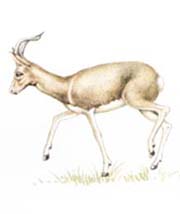| About China > Fauna & Flora > Class I Animals > Mammalia |
|
|
Przewalskis Gazelle
Also known as Sands Goat or Mongolian
Gazelle, it belongs to the Bovidae family of Artiodactyla order. Its Latin
scientific name is Procapra przewalskii, and its English name is Przewalski's
Gazille.
Its body is about 100 centimeters long, and weighs 21 to 32 kilograms, with a tail of about 7 to 10 centimeters. The whole body is in a yellowish brown color, with white spots on buttocks. Only the male develops antlers, which bend inward with the tines pointing at each other.
Przewalski's Gazelle dwells in flat areas and basins between mountains and the semi-desert zones around lakes. It usually moves about in groups of several or tens, and in winter forms larger groups. Przewalski's Gazelle feeds on plants of the sedge family, the grass family and other sands plants. Its estrum occurs in winter, and parturition takes place in the period from May to June, with one baby per fetus.
It was once widely distributed in Inner Mongolia Autonomous Region, Ningxia Hui Autonomous Region, Gansu and Qinghai provinces. Survey in 1996 showed that despite a few isolated groups of about 300 heads found on the north bank of the Qinghai Lake, Przewalski's Gazelle had probably died out in other regions.
Przewalski's Gazelle has been listed in Appendix I of International Trade Convention on Endangered Wild Animal and Plant Species. |
||||
 |
